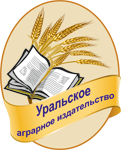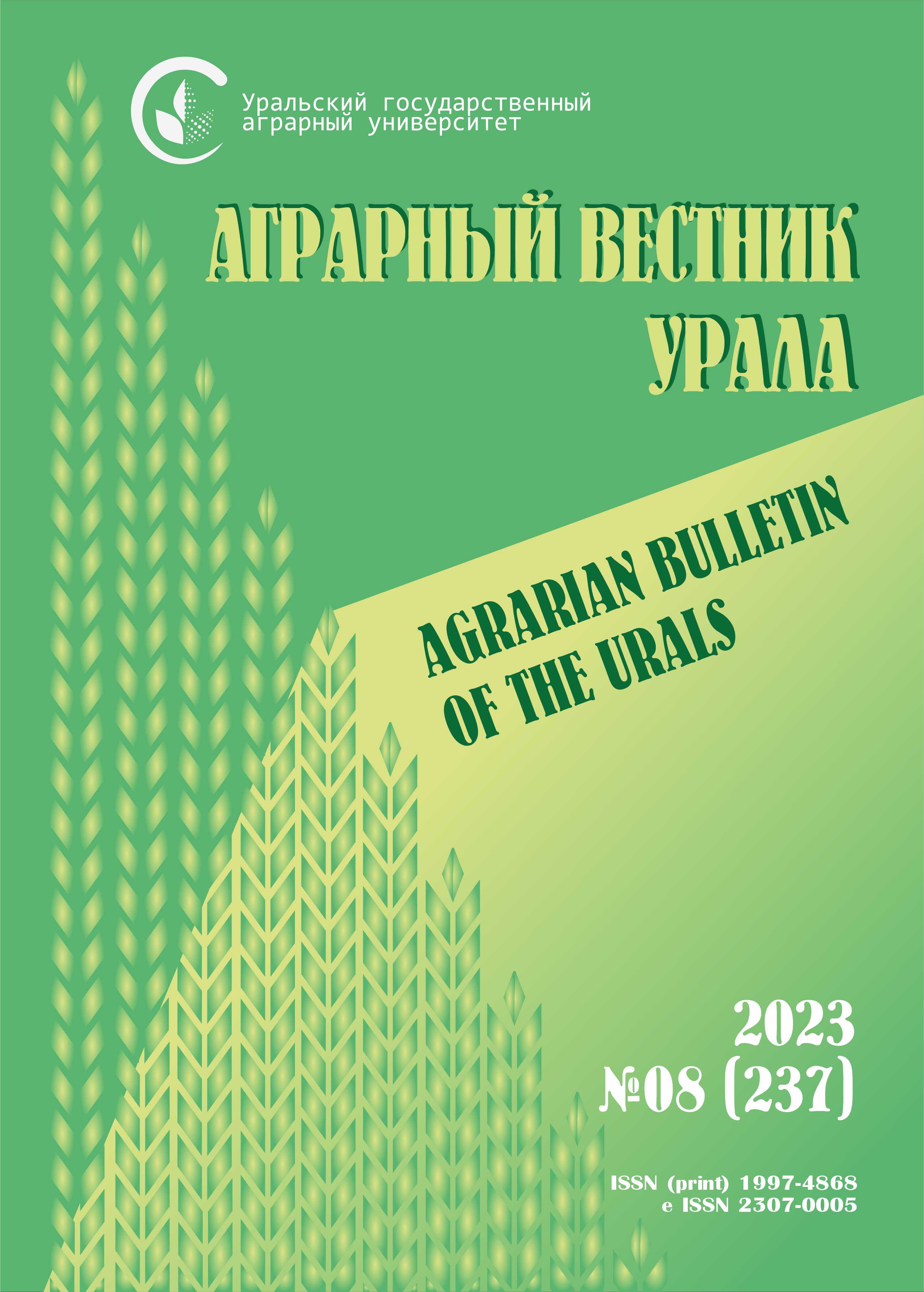Abstract. The purpose of the study is a comparative characteristic of the yield of peas in the production and state variety testing of the Tyumen region, as well as a comprehensive assessment of pea varieties by yield and adaptability parameters in the conditions of a subtaiga of the region. Methods. The studies were carried out on the basis of statistical data of the pea yield in the production and state variety testing of the Tyumen region for 2017–2021, as well as data on the results of state variety testing of the varieties admitted to use for 2019–2021 under the conditions of a subtaiga (Nizhne-Tavdinskiy and Aromashevskiy STP). Coefficient of index of environmental conditions (Ij), stress tolerance (Y2 – Y1), yield variability (v, %), plasticity (bi), stability (Si2) and general adaptive ability (GAA) were calculated. Results. The variety Bagu (30.5 and 33.0 c/ha, respectively) was the best in terms of average yield and average yield in contrast conditions, and in terms of realizing the yield potential the variety Kumir was the best (74.7 %). Stress tolerance is low in all varieties, from –19.7 (Yamal) to –27.3 (Tomas), and yield variability is significant, from 30.5 % (Bagu) to 42.7 % (Agrointel). Strong responsiveness to changes in conditions was noted in the variety Salamanca (bi = 1.13), which makes it possible to attribute it to intensive. The varieties Yamal (Si2 = 3.30) and Salamanka (Si2 = 4.36) were the best stability. The varieties Bagu (GAA = 3.3) and Salamanka (GAA = 2.5) were the largest general adaptive ability. The varieties Bagu (sum of ranks 19), Salamanca (sum of ranks 24), Yamal (sum of ranks 31) and Thomas (sum of ranks 33) were recognized as the best by the sum of the ranks of the parameters of yield and adaptability. Scientific novelty. The yield and adaptive potential of admitted to use of pea varieties was revealed based on the results of their testing in 6 environments using a number of methodological approaches. Practical significance. The ranking of varieties according to the parameters of yield and adaptability made it possible to identify the best varieties according to the complex of signs and properties in the conditions of the subtaiga of the Tyumen region.
peas, yield, variety, stress tolerance, yield variability, responsiveness, stability, general adaptive ability, rank of variety
1. Temirov K. S. Sravnitel'naya ocenka selekcionnyh liniy goroha razlichnogo morfotipa // Sibirskiy vestnik sel'skohozyaystvennoy nauki. 2019. T. 49. № 2. S. 28-35. DOI:https://doi.org/10.26898/0370-8799-2019-5-4. EDN: https://elibrary.ru/DGCMQN
2. Shukis S. K., Shukis E. R., Drobyshev A. P. Biologicheskaya osobennost' sortov i liniy goroha posevnogo i ih reakciya na sroki poseva v usloviyah Altayskogo kraya // Vestnik Altayskogo GAU. 2021. № 9 (203). S. 36-43. DOI:https://doi.org/10.53083/1996-4277-2021-203-36-43. EDN: https://elibrary.ru/CDSZKE
3. Davletov F. A., Nigmatullina G. M., Gaynullina K. P., Pleshkov A. V., Safin F. F. Novyy sort zernovogo goroha Pamyati Popova // Zernovoe hozyaystvo Rossii. 2020. № 2 (68). S. 61-65. DOI:https://doi.org/10.31367/2079-8725-2020-68-2-61-65. EDN: https://elibrary.ru/BZBANO
4. Ashiev A. R., Habibullin K. N., Chegunova A. V., Skulova M. V. Ocenka urozhaynosti zerna novyh liniy goroha posevnogo i opredelenie parametrov ih adaptivnosti // Zernovoe hozyaystvo Rossii. 2021. № 4 (76). S. 45-49. DOI:https://doi.org/10.31367/2079-8725-2021-76-4-45-49. EDN: https://elibrary.ru/VIYNTH
5. Fadeeva I. D., Tagirov M. Sh., Gazizov I. N. Vliyanie srokov poseva i norm vyseva na urozhaynost' novyh sortov ozimoy pshenicy // Zemledelie. 2019. № 3. S. 21-23. DOI:https://doi.org/10.24411/0044-3913-2019-10305. EDN: https://elibrary.ru/WNGHNL
6. Novohatin V. V. Nauchnoe obosnovanie pervichnogo i elitnogo semenovodstva zernovyh kul'tur // Dostizheniya nauki i tehniki APK. 2018. № 32 (9). S. 40-47. DOI:https://doi.org/10.24411/0235-2451-2018-109. DOI: https://doi.org/10.24411/0235-2451-2018-10910; EDN: https://elibrary.ru/VKMRBX
7. Dragavtsev V. A. Solutions of technologic problems of breeding yield increasing, which issue from the Theory of eco-genetik organization of quantitatiue characters // East European Scientific Journal. 2019. No. 2 (42). Pp. 11-26.
8. Ashiev A. R., Habibullin K. N., Skulova M. V., Chegunova A. V. Klasternyy analiz kollekcionnogo materiala goroha s genami usatogo tipa lista (af) i neosypaemosti semyan (def) // Zernovoe hozyaystvo Rossii. 2021. № 2 (74). S. 40-44. DOI:https://doi.org/10.31367/2079-8725-2021-74-2-40-44. EDN: https://elibrary.ru/DUSXER
9. Dragavcev V. A., Dragavceva I. A., Efimova I. L., Kuznecova A. P., Morenec A. S. K eksperimental'nomu podtverzhdeniyu gipotezy ob ekologo-geneticheskoy prirode fenomena «vzaimodeystvie genotip - sreda» u drevesnyh rasteniy // Sel'skohozyaystvennaya biologiya. 2018. T. 53. № 1. S. 151-156. DOI:https://doi.org/10.15389/agrobiology.2018.1.151 rus. DOI: https://doi.org/10.15389/agrobiology.2018.1.151rus; EDN: https://elibrary.ru/VZWYIP
10. Sapega V. A., Tursumbekova G. Sh. Interaction of genotype-environment, yield and adaptive potential of oat varieties in conditions of subtaiga of the Northern Trans-Urals // IOP Conference Series: Materials Science and Engineering. 2022. Vol. 1045. Article number 012077. DOI:https://doi.org/10.1088/1755-1315/1045/1/012077. EDN: https://elibrary.ru/VSVYPD
11. Pereira H. S., Alvares R. C., Silva F. C., de Faria L. C., Melo L. C. Genetic environmental and genotype environment interaction effects on the common bean grain yield and commercial quality // Semina: Ciencias Agrarias. 2017. Vol. 38 (3). Rr. 1241-1250. DOI:https://doi.org/10.5433/1679-0359.2017v38n3p1241.
12. Novohatin V. V., Dragavcev V. A., Leonova T. A., Shelomenceva T. V. Sozdanie sorta myagkoy yarovoy pshenicy Grenada s pomosch'yu innovacionnyh tehnologiy selekcii na osnove teorii ekologo-geneticheskoy organizacii kolichestvennyh priznakov // Sel'skohozyaystvennaya biologiya. 2019. T. 54. № 5. S. 905-919. DOI:https://doi.org/10.15389/agrobiology.2019.5.905 rus. DOI: https://doi.org/10.15389/agrobiology.2019.5.905rus; EDN: https://elibrary.ru/MYLRVF
13. Vologzhanina E. N., Batalova G. A. Urozhaynost' i adaptivnye svoystva sortov plenchatogo ovsa v Volgo-Vyatskom regione // Vestnik Altayskogo GAU. 2019. № 3 (173). S. 31-36. EDN: https://elibrary.ru/IHVLJR
14. Admas S., Tesfaye K. Genotype-by-environment interaction and yield stability analysis in sorghum (Sorghum bicolor (L.) Moench) genotypes in North Shewa, Ethiopia. Acta Universitatis Sapientiae // Agriculture and Environment. 2017. Vol. 9 (1). Rr. 82-94. DOI:https://doi.org/10.1515/ausae-2017-0008.
15. Hlestkina E. K., Zhuravleva E. V., Pshenichnikova T. A., Usenko N. I., Morozova E. V., Osipova S. V., Permyakova M. D., Afonnikov D. A., Otmahova Yu. S. Realizaciya geneticheskogo potenciala sortov myagkoy pshenicy pod vliyaniem usloviy vneshney sredy: sovremennye vozmozhnosti uluchsheniya kachestva zerna i hlebopekarnoy produkcii (obzor) // Sel'skohozyaystvennaya biologiya. 2017. T. 52. № 3. S. 501-514. DOI:https://doi.org/10.15389/agrobiology.2017.3.501rus. EDN: https://elibrary.ru/YZKVHR
16. Mal'chikov. P. N., Rozova M. A., Morgunov A. I., Myasnikova M. G., Zelenskiy Yu.I. Velichina i stabil'nost' urozhaynosti sovremennogo selekcionnogo materiala yarovoy tverdoy pshenicy (Triticum durum Dest.) iz Rossii i Kazahstana // Vavilovskiy zhurnal genetiki i selekcii. 2018. T. 22. № 8. S. 939-950. DOI: 10.18699/ vj18436. DOI: https://doi.org/10.18699/VJ18.436; EDN: https://elibrary.ru/YQNNPV
17. Sapega V. A., Mitrikovskiy A. Ya. Ocenka urozhaynogo i adaptivnogo potenciala sortov goroha v usloviyah yuzhnoy lesostepi Severnogo Zaural'ya // Vestnik Kazanskogo GAU. 2020. № 2 (58). S. 49-52. DOI:https://doi.org/10.12737/2073-0462-2020-49-52. EDN: https://elibrary.ru/LKSSQR
18. Novohatin V. V., Shelomenceva T. V., Dragavcev V. A. Novyy kompleksnyy podhod k izucheniyu dinamiki povysheniya adaptivnosti i gomeostatichnosti u sortov myagkoy yarovoy pshenicy (na primere dlitel'noy istorii selekcii v Severnom Zaural'e) // Sel'skohozyaystvennaya biologiya. 2022. T. 57. № 1. S. 81-97. DOI:https://doi.org/10.15389/agrobiology.2022.1.81 rus. DOI: https://doi.org/10.15389/agrobiology.2022.1.81rus; EDN: https://elibrary.ru/DAYGED
19. Levakova O. V. Selekcionnaya rabota po sozdaniyu adaptirovannyh k Nechernozemnoy zone RF sortov yarovogo yachmenya i perspektivy razvitiya dannoy kul'tury v Ryazanskoy oblasti // Zernovoe hozyaystvo Rossii. 2021. № 1 (73). S. 14-19. DOI:https://doi.org/10.31367/2079-8725-2021-73-1-14-19. EDN: https://elibrary.ru/KZPJMO
20. Nikolaev P. N., Yusova O. A., Popolzuhin P. V., Anis'kov N. I., Safonova I. V. Adaptivnyy potencial sortov yarovogo yachmenya selekcii Omskogo agrarnogo nauchnogo centra // Zemledelie. 2019. № 1. S. 35-38. DOI:https://doi.org/10.24411/0044-3913-2019-10110. EDN: https://elibrary.ru/YXTVID
21. Cheshkova A. F., Stepochkin P. I., Aleynikov A. F., Grebennikova I. G., Ponomarenko V. I. Sravnenie statisticheskih metodov ocenki stabil'nosti urozhaynosti ozimoy pshenicy // Vavilovskiy zhurnal genetiki i selekcii. 2020. T. 24. № 3. S. 267-275. DOI:https://doi.org/10.18699/vj20.619. EDN: https://elibrary.ru/HKAOWK
22. Rekashus E. S. Sovremennye metody ocenki produktivnosti i stabil'nosti selekcionnyh dostizheniy (obzor) // Dostizheniya nauki i tehniki APK. 2022. T. 36. № 4. S. 52-60. DOI:https://doi.org/10.53859/02352451-2022-36-4-52. DOI: https://doi.org/10.53859/02352451_2022_36_4_52; EDN: https://elibrary.ru/FYLLLA
23. Vydrin V. V., Fedoruk T. K. Sortovoe rayonirovanie sel'skohozyaystvennyh kul'tur i rezul'taty sortoispytaniya po Tyumenskoy oblasti za 2021 god. Tyumen': Tyumenskiy izdatel'skiy dom, 2021. 95 s.
24. Dospehov B. A. Metodika polevogo opyta (s osnovami statisticheskoy obrabotki rezul'tatov issledovaniy). Moskva: Al'yans, 2014. 351 s.
25. Nettevich E. D. Potencial urozhaynosti rekomendovannyh dlya vozdelyvaniya v central'nom regione RF sortov yarovoy pshenicy i yachmenya i ego realizaciya v usloviyah proizvodstva // Doklady RASHN. 2001. № 3. S. 3-6.
26. Rossielle A. A., Hamblin J. Theoretical aspects of selection for yield in stress and non-stress environments // Crop Science. 1981. Vol. 21. No. 6. Pr. 27-29.
27. Eberhart S. A., Russell W. A. Stability parameters for comparing varieties // Crop Science. 1966. Vol. 6. No. 1. Pp. 36-40.
28. Kil'chevskiy A. V., Hotyleva L. V. Ekologicheskaya selekciya rasteniy. Minsk: Tehnologiya, 1997. 372 s. EDN: https://elibrary.ru/FFLTCU
29. Goncharenko A. A. Ekologicheskaya ustoychivost' sortov zernovyh kul'tur i zadachi selekcii // Zernovoe hozyaystvo Rossii. 2016. № 2 (44). S. 31-36.
30. Shamanin V. P., Potockaya I. V., Shepelev S. S., Pozherukova V. E., Morgunov A. I. Morfometricheskie parametry kornevoy sistemy i produktivnost' rasteniy u sinteticheskih liniy yarovoy myagkoy pshenicy v usloviyah Zapadnoy Sibiri v svyazi s zasuhoustoychivost'yu // Sel'skohozyaystvennaya biologiya. 2018. T. 53. № 3. S. 587-597. DOI:https://doi.org/10.15389/agrobiology.2018.3.587rus. EDN: https://elibrary.ru/XUBBYT









